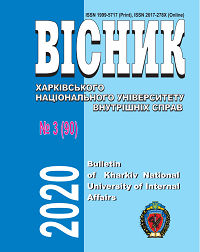The European Court of Human Rights as Part of Criminal Procedural Legislation of Ukraine
DOI:
https://doi.org/10.32631/v.2020.3.23Keywords:
European Court of Human Rights, case law of the European Court of Human Rights, Convention for the Protection of Human Rights and Fundamental Freedoms, committee, criminal procedural legislation of Ukraine.Abstract
The author has studied the issue of the origin and formation of the European Court of Human Rights after the Second World War, steps in the establishment and development of this Court, as well as the actions of the Member States to consolidate the development of the European Court of Human Rights at specialized conferences with the support of the Committee of Ministers. The list of regulatory and legislative acts adopted by the Verkhovna Rada of Ukraine for the establishment of the rule of law in regard to the understanding of human rights in the activities of Ukrainian courts has been researched. Since the Convention for the Protection of Human Rights and Fundamental Freedoms has become part of national legislation after its ratification by the Verkhovna Rada of Ukraine, more detailed study should be conducted regarding the urgent task of fully understanding the content of this international treaty and the main mechanisms for implementing its norms. The author has analyzed the implementation of the case law of the European Court of Human Rights on the example of its specific decisions into criminal procedural legislation of Ukraine by applying the decisions of the European Court of Human Rights by the Grand Chamber of the Supreme Court in its activities and problematic aspects of their practical implementation. Particular attention has been paid to the study of problematic aspects of the use of these decisions in practice by highlighting the rulings of the Grand Chamber of the Supreme Court issued in 2019. The author has analyzed the decisions of the European Court of Human Rights in regard to the conducted secret (search) actions by law enforcement agencies with further disclosure ob obtained evidence to the defense party; it has been also pointed out that the right to disclose evidence contained in criminal proceedings is not absolute to the defense and may be limited only in cases when there are the interests of national security, information protection or witness protection concerning the methods and forms of law enforcement agencies’ activity. The author has made propositions to resolve certain situations related to the implementation of the decisions of the European Court of Human Rights in Ukraine.
Downloads
References
Shevchuk S.V., 2007. Judicial protection of human rights. The case law of the European Court of Human Rights in the context of the Western legal tradition [Sudovii zakhyst prav liudyny. Praktyka Yevropeiskoho sudu z prav liudyny u kontekstі zakhіdnoi pravovoi tradytsіi]. Kyiv: Referat.
Arkhipova L.B., 1996. Human rights: an ongoing challenge for the Council of Europe [Prava cheloveka: postoyannaya zadacha Soveta Evropy]. Moscow: Prava cheloveka.
Alisievich E.S., 2006. Interpretation of the norms of the Council of Europe Convention for the Protection of Human Rights and Fundamental Freedoms as the competence of the European Court of Human Rights [Tolkovanie norm Konventsii Soveta Evropy o zashchite prav cheloveka i osnovnykh svobod kak pravomochie Evropeiskogo Suda po pravam cheloveka]. Abstract of Ph.D. dissertation. Institute of State and Law of the Russian Academy of Sciences.
Bilas Yu.Yu., 2011. European standards of human rights in the context of legal status of contemporary Ukraine [Yevropeiskі standarty prav liudyny v kontekstі pravozastosuvannia suchasnoi Ukrainy]. Abstract of Ph.D. dissertation. National Academy of Internal Affairs.
Andrushchenko K.A., 2013. Concept of "margin of appreciation" that pledged freedom to the judiciary of powers [Kontseptsіia «margin of appreciation» ta obsyah svobody rozsudu derzhav]. In: Strategy and tactics of legal reforms: victories of success [Stratehіia і taktyka pravovykh reform: vyklyky suchasnostі]. Available at http://legalactivity.com.ua/index.php?option=com_content&view= article&id=475%3A050313-10&catid=61%3A2-0313&Itemid=76&lang=ru [Accessed 26 September 2020].



